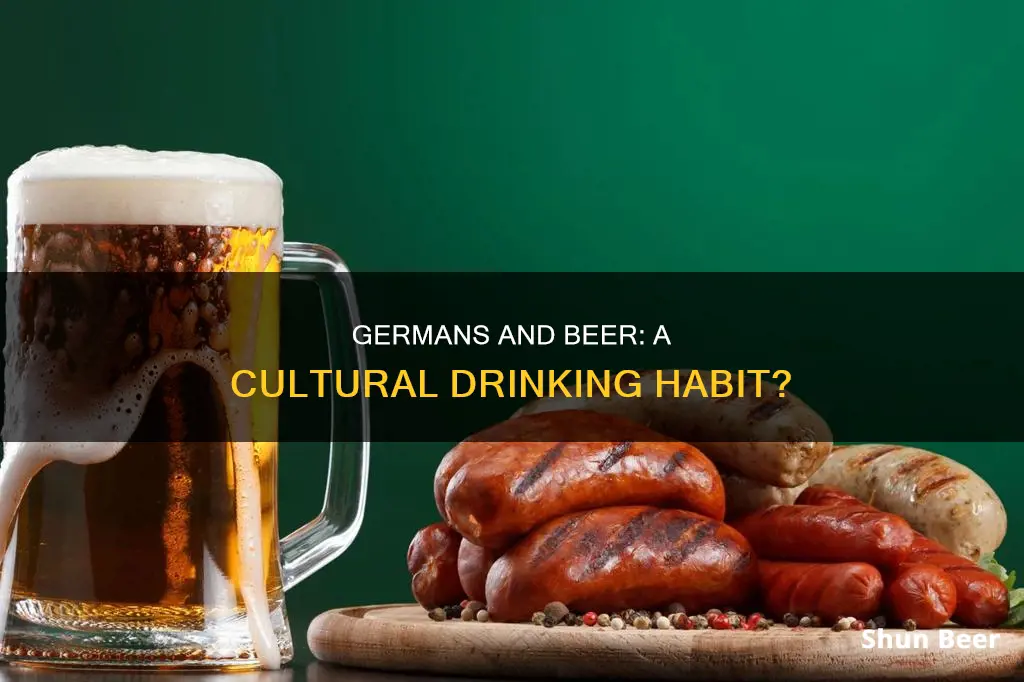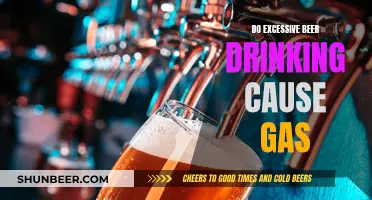
Germany has a strong drinking culture, with alcohol consumption being a part of daily life for many adults. Beer is the most popular alcoholic drink in the country, with Germans consuming an average of over 100 litres per year. This may be because beer is relatively accessible in Germany, with drinking in public being generally legal and considered socially normal. The country also has lenient laws regulating alcohol use and sale, with one of the lowest drinking ages in the world. While some Germans do drink beer with meals, it is not accurate to say that all Germans drink beer with every meal. However, it is common to have beer for breakfast in the form of a traditional Weißwurstfrühstück, which includes sausage, pretzels, sweet mustard, and wheat beer.
| Characteristics | Values |
|---|---|
| Drinking beer with meals | Common, especially in the morning with a traditional Bavarian breakfast |
| Alcohol laws | Lenient, with one of the lowest drinking ages in the world |
| Alcohol consumption | High, with Germany having the fifth-highest per capita alcohol consumption worldwide in 2016 |
| Alcoholism | 1.7 million people were dependent on alcohol and needed treatment in 2006 |
| Beer consumption | On average, Germans drink over 100 liters of beer per year |
What You'll Learn

Beer is consumed with breakfast in Germany
Germany has a strong drinking culture, with alcohol forming a part of daily life for many adults. Beer is the most popular alcoholic drink in the country, with Germans consuming over 100 litres per year on average. With over 1300 breweries, there is no shortage of regional beers to choose from.
Beer is so ingrained in German culture that it is often consumed with breakfast. A traditional Bavarian breakfast, known as a "Weißwurstfrühstück", consists of white sausages, soft pretzels, sweet mustard, and wheat beer. This meal is typically enjoyed before noon on Saturdays in the south of Munich and is seen as an excuse for an informal get-together. The pub Gaststätte Großmarkthalle, run by a brother-and-sister duo, is particularly famous for its Weißwurstfrühstück.
While some may view drinking beer with breakfast as unusual, it is not uncommon in Germany. In fact, beer is sometimes referred to as "fluid bread", reflecting its staple status in the country's diet. The country's lenient alcohol laws and low drinking age also contribute to the normalisation of beer consumption.
However, it is important to note that excessive alcohol consumption can lead to health issues. According to statistics, approximately 1.7 million people in Germany were dependent on alcohol and required treatment in 2006, while 2.7 million consumed alcohol in a harmful way.
Non-alcoholic Beer: Safe or Risky for People in Recovery?
You may want to see also

Germany has lenient alcohol laws
Germany has a lenient approach to alcohol laws, which is reflected in its drinking culture. Alcoholic beverages are considered a part of everyday life, with beer being the most popular alcoholic drink. The country has one of the lowest drinking ages in the world, allowing minors as young as 14 to consume and possess undistilled alcoholic beverages like beer and wine when accompanied by a parent or guardian. At 16, minors can drink these beverages without supervision, and at 18, they gain access to distilled spirits.
German alcohol laws focus on youth protection but are designed to teach young people appropriate drinking habits rather than keep them away from alcohol entirely. This approach has led to a graduated drinking culture based on age. The country's tax rates for alcoholic drinks are below average for Europe, and there are minimal regulations governing availability. Drinking in public is generally legal and socially accepted, although there are some exceptions during football matches and on certain religious holidays.
The German language and culture are deeply intertwined with beer. Beer is the main attraction at beer gardens, brewery tours, and Oktoberfest, the world's largest beer festival. Germans even have a term, "bierernst," meaning "beer-serious," to describe someone who is too serious. The country's famous purity laws for beer date back 500 years, allowing only water, malt, hops, and yeast as ingredients.
While Germany's relaxed alcohol laws have made drinking a normal part of social life, there are concerns about alcohol abuse and its impact on public health. Studies have found high rates of risky drinking and alcohol dependence among German adults and problem drinking among young people. Despite these concerns, Germany's alcohol industry holds significant political influence, preventing the implementation of stricter regulations.
Mixing Beer and Red Wine: A Good Idea?
You may want to see also

Beer is used in cooking
While it is true that Germans love to drink beer, and it is a major part of German culture, it is also used in cooking. German cooks use beer instead of water in their recipes, adding a distinct bitter-sweet flavour to soups, sauces, marinades, and even vegetables.
Beer is often used in marinades for meat, such as chicken, pork chops, and pork knuckles. It is also used to baste knackwurst and to make sauces for roast pork loin and pork tenderloin. Beer is also used to make coleslaw and to cook vegetables such as brussel sprouts.
There are also several German soups that use beer, such as dark beer onion soup, German cheese and beer soup, and sauerbraten. Beer is also used to make punches and coolers, such as dark beer punch and raspberry beer cooler.
Germans take the science of brewing very seriously, and it is said that this gave rise to Europe's first food purity law, passed in 1516 by Duke William IV of Bavaria. This law, still in force today, states that only barley, malt, hops, and water are allowed in the beer-making process.
Drinking Beer While on Celexa: What You Need to Know
You may want to see also

Beer is a part of daily life for many German adults
Drinking in public is generally legal and socially normal in Germany, and beer is often consumed at mealtimes. For example, a traditional Bavarian breakfast, the Weißwurstfrühstück, consists of white sausages, soft pretzels, and sweet mustard, all accompanied by a wheat beer. This meal is seen as an excuse for an informal get-together, and people will often stay to enjoy the atmosphere and drink more beer.
The German laws regulating alcohol use and sale are relatively lenient compared to other countries and are focused on youth protection. The drinking culture in Germany is well-established, and alcohol consumption is publicly accepted. However, it is important to note that underage drinking is not encouraged, and there are laws in place to prevent the sale of alcoholic beverages to minors.
While beer is a common drink for German adults, it is not the only beverage of choice. Water, for example, is highly regulated in Germany due to its importance in daily life, and Germans also consume a significant amount of coffee.
Pirates' Favorite Drink: Beer or Not?
You may want to see also

Germany has an abundance of regional beers
Germany has a rich history of brewing and drinking beer, and it is considered a significant part of the country's culture. With more than 1,300 breweries producing over 5,000 different types of beer, it is no surprise that beer is the national drink of Germany.
Each region in Germany has its own particular type of beer and beer brands, which vary according to local ingredients and brewing traditions. This is why beer in Germany can differ so widely in taste, body, and density from one region to the next. Almost half of all German breweries are in Bavaria, where the seven main breweries produce 158 million US gallons (6 million hectoliters) annually. In total, about 1,300 breweries in Germany produce over 5,000 brands of beer, and there are now well over 7,000 varieties of beer in the country.
The southern region of Bavaria, with its capital, Munich, is home to the world-famous Oktoberfest beer festival. However, other cities also host hundreds of their own beer festivals and events throughout the year.
- Altbier: A top-fermented, lagered beer brewed only in Düsseldorf and the Lower Rhine region. It has a mildly bitter and hoppy taste, with an alcohol content of around 5-6.5%.
- Berliner Weisse: A pale, very sour, wheat beer brewed in Berlin. It typically has an alcohol content of 2.5-5% and is often served with raspberry- or woodruff-flavoured syrup.
- Gose: A sour wheat beer brewed with salt and coriander in Leipzig. It has a cloudy appearance and a tangy, spicy flavor.
- Kölsch: A pale, light-bodied, top-fermented beer that can only be legally brewed in the Cologne region. It has an alcohol content of around 4.5-5% and is typically served in a 200ml glass.
- Münchener Bier: A protected beer from Munich with a PGI status under EU law.
- Rauchbier: A smoked beer brewed in Bamberg in Upper Franconia. It has a unique smokey flavor and aroma.
- Roggenbier: A fairly dark beer made in Bavaria with rye, with a grainy flavor similar to bread. It has an alcohol content of around 4.5-6%.
Drinking Beer and Driving: How Many is Too Many?
You may want to see also
Frequently asked questions
Drinking is a part of daily life for many German adults, and beer is the most popular alcoholic drink in the country. However, it is not typical for Germans to drink beer with every meal.
While it is not typical for Germans to drink beer with every meal, there is a tradition of drinking beer for breakfast in the south of Munich. This tradition is known as "Weißwurstfrühstück", which is a meal consisting of white sausages, soft pretzels, sweet mustard, and wheat beer.
On average, Germans drink over 100 liters of beer per year. In 2006, approximately 1.7 million people in Germany were dependent on alcohol and needed treatment, and 2.7 million consumed alcohol in a harmful way.
The German laws regulating alcohol use and sale are focused on youth protection. Germany has one of the lowest drinking ages in the world, and drinking in public is generally legal and considered socially normal. However, there are laws against driving under the influence of alcohol, and occupational safety legislation has tightened to induce a decrease in alcohol consumption during working hours.







